
The fact is that the human body is surprisingly fragile despite being responsible for sheltering our internal organs from harm.
While our bodies are a marvel of biology, they cannot withstand extreme trauma without being damaged. That means we live our lives at general risk of injury whenever we step outside the safety of our homes.
With that said, the chances of getting seriously hurt are statistically low. Nevertheless, there are scenarios where the average odds of injury increase.
One of the most common situations where people get hurt is driving a motor vehicle, especially on populated roads. Motor vehicle collisions are among the most common sources of physical injury worldwide.
Still, other circumstances can generate similar or identical injuries to those sustained in a car crash, with some types of injuries being more common than others.
What is the most common injury in a car accident? The most common injury you can sustain in a car accident is whiplash (typically due to a rear-end collision), which you have almost certainly heard of or even experienced if you found this article.
If you have ever suffered a whiplash injury, you know it can be very painful.
Unfortunately, pop culture and stereotypes have caused many people to not seriously take someone suffering from whiplash and wearing a neck collar.
People assume the injured victim is faking and is only wearing an immobilization device like a cervical collar to help them sue the other driver.
However, that is far from being the truth, as whiplash injuries have the potential to cause significant and even permanent harm to the body.
Some whiplash injuries are much more severe than others and require more serious treatments and surgical interventions.
However, not every instance of whiplash is inherently severe. The level and rate of severity you can suffer falls under a range, which is why doctors use a grading system and perform systematic reviews to rate whiplash injuries by severity.
Whiplash Grading System:
The grade of your whiplash is used to determine how severe the damage to the cervical spine is and acts as a guide for doctors to know what the proper neck pain relief treatments are for their patients.
To begin, let’s start by defining what whiplash means.
What Is Whiplash?
In one sentence: Whiplash is a type of neck injury due to sudden and forceful, rapid back-and-forth movement of the cervical spine, like the back and forth of a cracking whip often resulting from car accidents (especially rear-end accidents).
To better understand why a whip inspired the term whiplash injuries, you can think of fictional movie characters, Indiana Jones or Catwoman, who both use this type of whip.
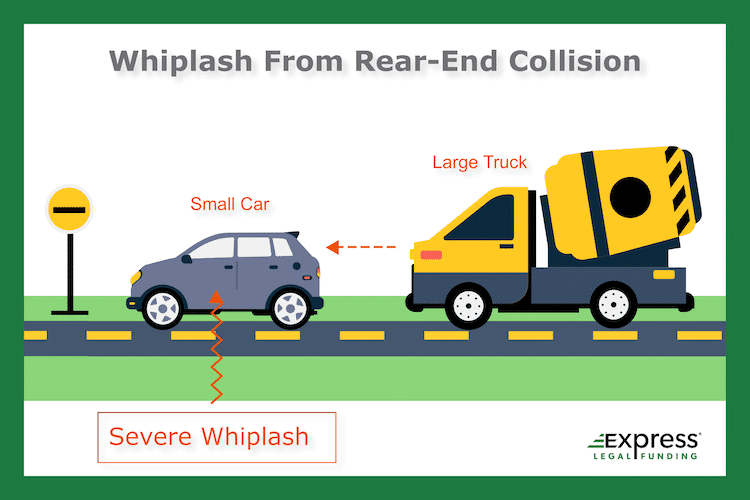
Understanding Whiplash Injuries
You might not know what is involved if you have never sustained a whiplash injury. In the simplest definition, whiplash is a neck injury that occurs whenever we are subjected to a sudden, rapid movement that causes our vertebral column to shift.
Essentially, rapid movement causes our neck to jerk suddenly, which strains the bone and, more importantly, affects our brains.
Whiplash, most commonly experienced in significant car accidents, occurs when the velocity of a vehicle suddenly changes.
The impact of such an event forces our bodies to move at rapid speeds before we can adequately brace ourselves, straining the bones in our neck and causing injury – particularly in rear-end collisions where we can’t foresee the accident.
The severity of the whiplash, gauged by how badly our necks were hyperextended or compressed, reflects the potential damage to our spinal cords and brains.
In severe instances, it can cause our brains to thrash about in our skulls, which can have profound consequences for our health.
What Causes Whiplash?
Acute whiplash injuries result from our bodies being subject to sudden, rapid, powerful movements. These movements create momentum that can influence our most valuable organ – the brain. The principle of inertia is vital to understanding how whiplash operates, a fundamental concept in physics.
Inertia refers to the property of physics, which is that an object will maintain its current state of motion – be it stillness or movement – unless influenced by an external force.
This means that an object at rest, such as our brain inside our skull, remains in its place until an unexpected force, such as a sudden acceleration or deceleration in a car accident, disrupts its state of rest.
That affects our bodies in a devastating way since our brains are at rest within our heads unless acted upon by the momentum of a sudden, rapid movement.
When muscles, joints, and ligaments are snapped beyond their typical range of motion, the injury results in a condition known as CAD (cervical acceleration/deceleration) syndrome.

The best example to consider is how we are affected when the car we are driving and our bodies are jerked back and forth by the momentum.
This usually causes us to bash against the steering wheel or another part of the car’s interior, such as the headrest behind you. This same principle applies to our brains, essentially passengers traveling in our skulls.
Enough force causes our sensitive soft tissue to bash against hard bone and inflict trauma on the body part essential to our lives.
True to the above scenario, the movement of our bodies during a car accident can significantly impact our brains, leading to potential injuries.
Unlike our bodies seatbelted in a car, our brains are not tightly secured and can move within our skulls. When subjected to sudden, powerful movements, our brains can collide with the hard bones, causing trauma and affecting our overall well-being.
This understanding is essential in helping us comprehend the following categorization of whiplash injuries, classified into five grades according to their severity.
What Are the Five Grades of Whiplash Injuries?
If you have been in an accident that caused a whiplash injury, you will likely experience symptoms that will alert you to the injury’s existence.
Unfortunately, not everyone recognizes they have signs of whiplash because they might not have experienced them before.
While there is no shame in not recognizing whiplash symptoms when you encounter them, a lack of knowledge could exacerbate the injury.
The biggest problem with whiplash is that the symptoms do not always manifest immediately after the crash, so you might walk away from it without realizing you were injured or without any acute whiplash injury symptoms.
Typically, whiplash symptoms manifest no later than 24 hours after the incident, but it has been known to happen sooner, with some people experiencing symptoms within 12 hours. The symptoms you experience because of the injury vary depending on your whiplash grade.
The symptoms of whiplash are typically divided into five grades with varying levels of pain and injury:
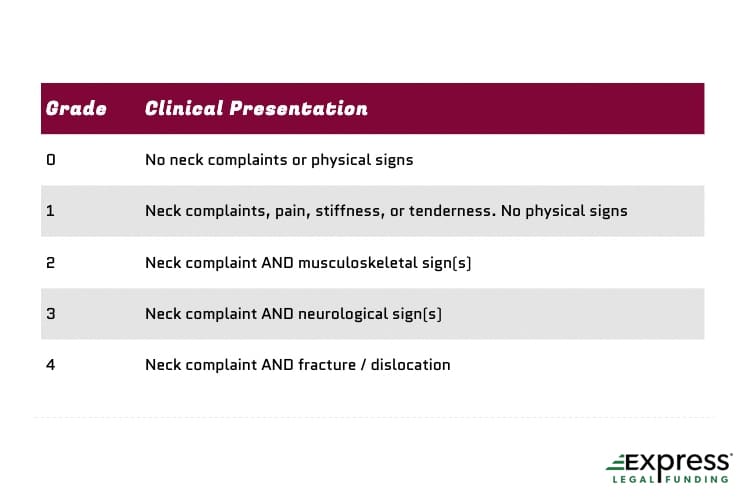
Five Grades of Whiplash
- Grade 0: No neck pain complaints or physical signs of injury
- Grade 1: Complaints of pain symptoms
- Grade 2: Complaints of pain and sign of physical injury
- Grade 3: Complaints of pain, including physical and neurological signs of brain injury
- Grade 4: Most serious level of whiplash, including severe pain and signs of potentially dangerous neurological impairment.
Grade 0:
Grade 0 is the most benign level of whiplash and is an injury in name only since there are no associated signs or symptoms. An individual with grade 0 whiplash experiences no neck pain or other symptoms typically associated with the injury.
Grade I:
Grade I is the second level of whiplash and the first stage in which injury symptoms afflict the victim. The initial symptom is pain in the affected area, but it also causes stiffness when moving and can cause point tenderness around the injured area.
Grade II:
Grade II is the whiplash level with most or all of the symptoms experienced with a grade I whiplash injury but also bears physical signs of tissue damage (i.e., soft-tissue injuries, bruises, swelling, etc.).
Additionally, the neck and back pain experienced by grade II whiplash patients can differ from grade I whiplash. Specifically, pain from a grade II whiplash injury radiates to nearby areas like your head, face, and back. You might also experience muscle spasms.
Grade III:
Grade III is the level of whiplash that is considerably more severe than the previous three levels since the symptoms extend to identifying the neurological signs of a brain injury.
You will likely experience some signs of grade I or II whiplash, but additional symptoms from grade III can exacerbate the pain and discomfort.
You might experience numbness, loss of sensation, headaches, vision loss, vertigo, tinnitus (ear ringing), and more. The symptoms of grade III whiplash are among the more severe, but they are still not considered the worst-case scenario insofar as whiplash injuries are concerned.
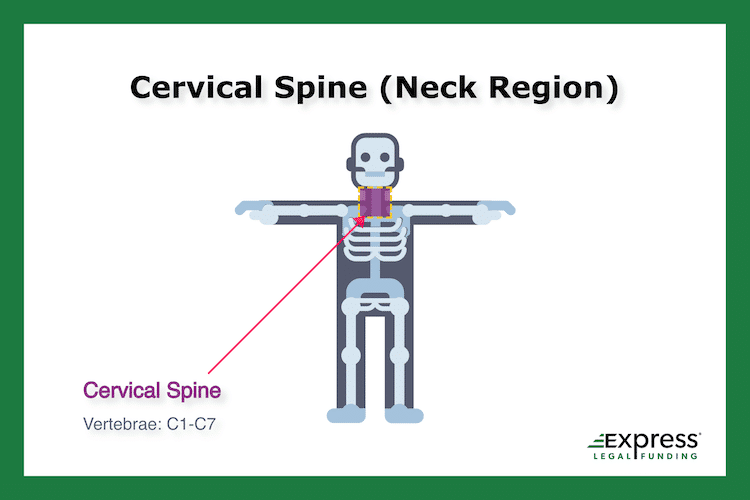
Grade IV:
Grade IV is the most severe level of whiplash and presents the most dangerous symptoms and consequences. Grade IV whiplash includes all the symptoms in grades I-III, except they are more severe due to extra physical trauma and chronic pain.
Grade IV whiplash is so severe because it usually means one cervical spine vertebra (C1-C7) is fractured or misaligned. That puts additional pressure on your nerves and causes serious physical ailments.
Whiplash comes in many varieties; each grade is more severe than the last as more symptoms are added. While the odds of developing a grade IV whiplash injury are low, it is still a risk factor worthy of consideration.
The risk of whiplash, regardless of grade, is elevated in people who play contact sports (i.e., football) or frequently ride roller coasters. The latter is less likely to cause serious whiplash injuries.
In contrast, the former usually does not cause grades III or IV unless you were involved in a significant altercation on the field.
What Is the Most Common Cause of Whiplash?
The most common source of whiplash injuries is motor vehicle collisions, which increase the risk of higher-grade injuries since vehicles often move at an average of 45 miles per hour on surface roads. The risk skyrockets on highways where speeds can average 75 miles per hour.
The greater the velocity and mass of the vehicle that rear-ends you compared to the car you are driving increases the odds of your suffering serious damage since the momentum translates directly to how hard you are thrown around.
The formula for this in physics is p = mv, which stands for momentum and is equal to the mass times the velocity of a moving object.
Therefore, someone else’s careless driving habits combined with a large amount of momentum can lead to a significant collision impact that severely damages your body, which will further strain your vertebral column and increase the risk of damage to your brain.
The velocity needed to generate higher-grade whiplash injuries means you likely will not develop one if your collision occurs on surface streets.
In general, motor vehicle accidents are more common on the highway and are more apt to result in whiplash. The odds of suffering a higher-grade whiplash injury are elevated on the highway.
Grading Accuracy and Recovery
Correctly determining and grading the level of a whiplash injury is very important. This grading system helps doctors decide the best treatment and helps estimate how quickly someone will recover.
Dr. Walter O. Spitzer created this system to help people better understand these injuries.

You can find more about this from the many DOI-cited whiplash studies on PubMed. For instance, you can read about the reliability of the grading system put forth Scientific Monograph of the Quebec Task Force on Whiplash-Associated Disorders (WAD), which discusses the grading system based on neck complaints and the associated.
Whiplash usually happens suddenly and can cause many symptoms. These can range from neck pain and muscle weakness to ringing in the ears, known as tinnitus.
As we have explained, Grades 0 to Grade IV describe how severe the injury is. Grade 0 means there’s no real neck pain or physical problem, while Grade IV is very serious and could mean a dislocation or even a brain injury.
Whiplash can cause a lot of different signs in the muscles and bones, especially soon after the injury. This can include impairment of being unable to move the neck fully, point tenderness, and sprains showing signs of soft tissue damage within the neck bones.
Nerve damage can cause problems beyond the typical bone and musculoskeletal signs, and you may need further checks and treatments.
Knowing the correct grade is critical for treatment. For example, a grade II whiplash injury, with pain when touched and limited neck movement, might be helped with physiotherapy (physical therapy) to regain proper range of motion and neck movement.
But a more severe grade IV injury might need to keep the neck still with a neck brace to avoid further damage.
Insurance companies often utilize whiplash grades to determine the treatments they will cover. The grading system developed by Dr. Walter Spitzer facilitates better communication among patients, healthcare providers, and insurance companies.
This standardized system simplifies assessing and understanding the severity of whiplash injuries. By accurately determining the grade of the injury, insurers can make informed decisions regarding coverage for treatments such as chiropractic care, muscle relaxants, and physiotherapy.
Employing this grading system ensures that patients receive appropriate and necessary care, aiding their recovery and overall quality of life.
Getting the grade right is essential, not just for science but also for patients’ quality of life. An incorrect grade might lead to the wrong treatment, which could make the injury worse and slow down recovery.
Plus, the emotional impact of a misdiagnosed sudden whiplash injury shouldn’t be overlooked, which is all the more the reason why chiropractors, physical therapists, and other health professionals need to be careful when checking and grading whiplash injuries to ensure patients get better as quickly as possible.
Whiplash and Car Accident Lawsuits
Despite there being multiple potential causes of whiplash, motor vehicle collisions are among the leading causes of such injuries.
Considering how common motor vehicle collisions have become in modern society, this can be a disturbing trend for people who want to avoid getting injured.
Most motor vehicle collisions involve multiple drivers, usually because one person was not paying enough attention to the road and drove into someone else.
These accidents can occur even if you follow every law and pay attention to the road. One negligent driver could undo your caution and diligence while injuring you and possibly destroying your vehicle.
Depending on what kind of road you are on (surface street, highway, etc.), the collision could transfer enough momentum to cause a grade IV whiplash injury.
These collisions leave you dealing with physical trauma, lost property, and financial damage that can seem impossible to repair without some sort of financial windfall.
Fortunately, civil law in the US does not expect motor vehicle collision victims to shoulder the financial burden. There are means by which people hurt by someone else’s negligence can seek legal recourse.
Injured victims can file a lawsuit against the at-fault driver (or their own insurance company to receive compensation.)
If you were involved in a collision that injured and damaged your vehicle, it is crucial that you seek medical attention immediately. (Not only for your health but to maximize how much you can be compensated for your loss.)
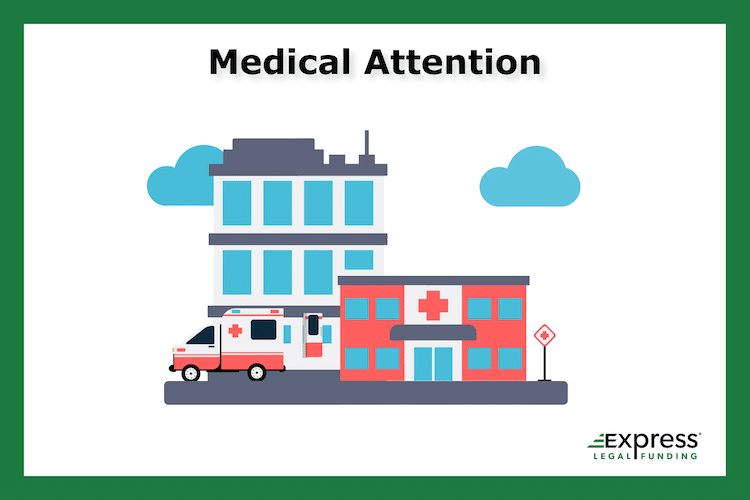
Once your initial treatment at the emergency room or urgent care clinic is complete, you can begin scheduling follow-up care from specialists and look into repairing or replacing your vehicle, depending on the extent of the damage.
Either way, you will face a hefty sum of repair and costly treatment expenses that can easily overwhelm you. Depending on the severity, those who have suffered whiplash may need one or more of the following treatments.
All of which can add up to tens of thousands of dollars in medical bills.
How Is Whiplash Treated?
Some of the most common treatment options for acute whiplash-associated disorders (WAD) include:
- Physical therapy exercises
- Manual manipulation (chiropractic work)
- Immobilization (neck brace)
- Medicine: Painkillers, anti-inflammatories, muscle relaxers (to prevent neck spasms)
- Cervical fusion spine surgery.
- Epidural steroid injections
- TENS unit (A medical treatment device that uses electrodes to stimulate the nerves in the damaged regions to provide temporary pain relief.)
- Cold packs to reduce swelling
- Applying heat to the damaged area (often by placing a hot pack wrapped in a towel to rest on the neck and shoulders before or after performing physical therapy exercises)

In addition to the above treatments, you will likely incur the high cost of diagnostic imaging used to detect bone fractures, which can include:
- X-rays
- MRIs
- CT Scans
These costly treatments, alongside injuries and damages, are sufficient cause to file a personal injury lawsuit against the other driver, whose insurance company will be contacted and brought in to assess the situation.
Whiplash Injury Settlement
These claims usually end in a settlement for the plaintiff designed to help them recover from the otherwise avoidable economic consequences of the collision.
The main goal of a personal injury settlement is to ensure the victim does not have to pay their medical bills out-of-pocket.
As a result, the settlement should be enough to prevent them from having to use their savings to pay medical providers.
Depending on the accident’s severity, you might have sustained a serious whiplash injury and required additional treatment. This directly affects the settlement total since the cost of that treatment must be considered in the negotiations.
You must prove you sustained the injury and received the appropriate treatment via copies of medical records and bills. This information will reduce or eliminate the adjusters’ ability to claim their client was not responsible for your injuries.
Whiplash and Concussion Settlement
Additionally, personal injury settlements factor in the loss of income you have due to your being unable to work while you recover from the whiplash and its accompanying injuries.
For example, you may miss work and make less money due to your suffering from a concussion or swelling in the brain stem area, which does not appear on CT scans.
Nonetheless, these acute whiplash-associated disorders can be debilitating and take several months to even years to recover from. Personal injury settlements are intended to compensate you for missing work, as well.
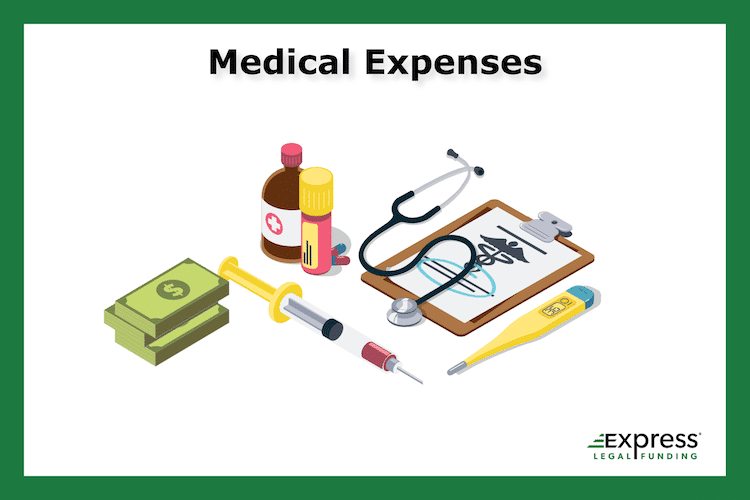
Unfortunately, other financial issues arise from needing to file a personal injury lawsuit.
Closing Statements on Grading Whiplash Injuries
While whiplash injuries are the most common type of personal injury resulting from a car accident, they vary in severity and require treatment.
Unfortunately, the effects of whiplash can be permanent and could require lifelong care to overcome and reduce.
These situations make filing personal injury and car accident lawsuits to seek a settlement so critical.
The harsh reality is that in addition to the pain you will have if you suffer whiplash in a car accident, your expenses will increase (medical bills and vehicle repair costs, etc.)
All the while, you still have financial responsibilities not related to the injury, such as paying your rent, car mortgages, food, and electricity.
We at Express Legal Funding understand this reality and that legal proceedings are stressful, especially when you are in pain, which is when we can come in to help.
We are a trusted pre-settlement funding company, which means we can advance you some of your potential settlement money to use now while your case is ongoing. So you can have money when you need it.
Lawsuit Funding for Whiplash Car Accident Cases
How legal funding works from a contract perspective is that we can purchase a piece of your claim by placing a lien on the potential settlement or trial award money and not on you, the client.
It’s a non-recourse agreement, not a loan, so we only get paid if you recover money from your claim. We win when your claims resolve successfully.

That means pre-settlement funding is risk-free since if you go to court but unfortunately lose it, you don’t owe us any money, and the pre-settlement money is yours to keep.
That’s because legal funding companies purchase part of the potential case proceeds, and when you lose, that potential case money is gone. It’s worry and personal debt-free.
So at the end of the day, pre-settlement funding can be a great financial option if you need money now but can’t access funds from elsewhere. That’s what we are here for and how we can help.
So if you need money now and not only later after your case ends, give us a call. We answer legal funding application calls anytime, 24/7.
(It is important to note that the money we are licensed to provide to plaintiffs in Missouri is a loan and, therefore, not risk-free. Pre-settlement loans in states like Missouri are loans and must, technically by law, be repaid. Express Legal Funding-Missouri, LLC is licensed to give these loans in MO)
